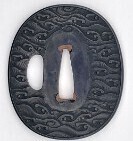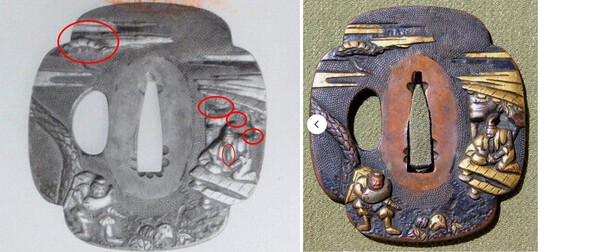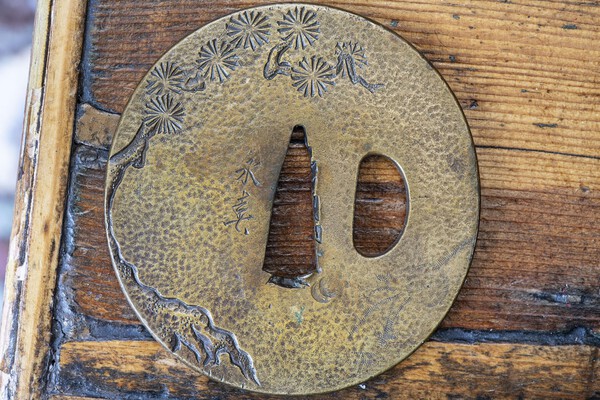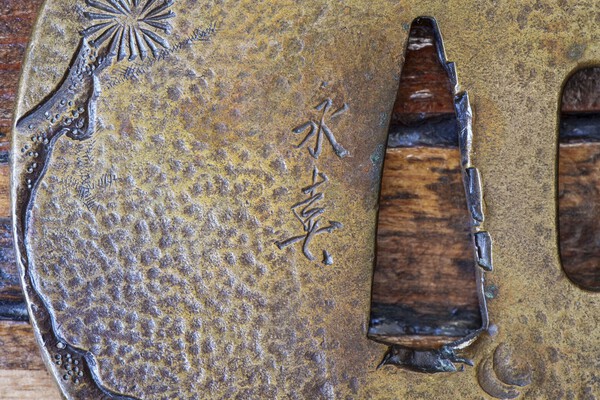-
Posts
142 -
Joined
-
Last visited
Everything posted by Jesta
-
I believe Quixotic might be a good term Something that is done from time to time on the board might be valuable if it was collated is to provide a list of red flags, with examples, for people to look out for. This is something that you do here for individual pieces (and in your books). Rather than try to find all the examples of all the fakes it might be better to find examples of the all the typical features that fakes tend to have. With the understanding that not all fakes will have all, or even any of them, and some real tsuba might have one or two. But… if a piece has too many red flags then probably better to walk away…
-
Thank you. I find your work in this area incredibly useful because I get so much education from reading the descriptions, and looking at the pictures. For my own collecting, I am back to exploring the concept of “fake”. I can certainly say agree something can be old, and yet be judged to be without much merit in terms of its rarity, craftsmanship, etc, but then it is down to an informed judgement about what appeals or not. So, when an Edo period tsuba is mass-produced I would tend to say that it is not a “fake” but it might not be considered as desirable as something that was handmade and largely unique (although the concept of “unique” is a hard one to nail down since themes and styles were much copied during the Edo period…). This makes starting a collection pretty hard, especially when pieces are sometimes described as “fake” with little real clarity on how they are labelled like that. Which is why I appreciate your detailed work so much… (this is off the top of my head, so take it for what it is worth) I wonder if a possible way would be to create a taxonomy to help new/existing collectors understand how things might be perceived by the wider community. Something like this: Main families Edo period Meiji period Modern Sub-categories Deliberate attempt to deceive (gimei, modern copies, etc) Handmade Mass-produced Created for use Created for art Created for sale to “tourists" Artistic merit, perceived craftsmanship quality would have to be a personal judgement, I think, with value determined by a willingness to buy it at the price offered. On a personal note, I have started to record the provenance of items that I buy, if there is any. This is (much like in the fine art world) to help provide a paper trail for the items to help future collectors know at the very least how long this piece has been in the hands of other collectors, or passed through auction houses etc.
-
Given that some tsuba were mass-produced in the Edo or early Meiji periods, is there a consensus on what qualifies as a “fake”? Is there a cutoff date that is generally agreed up as the point at which authentic becomes fake? I know that some modern tsuba are still being made, and may be collectible in their own right, but I am referring to purported antiques.
-

Line Auctioneers- Huge Suspect Lot (Mostly Tosogu) From Beverly Hills
Jesta replied to cluckdaddy76's topic in Tosogu
I am always worried by antiques being advertised as “authentic” and “genuine”. It screams “honest, guv, no word of a lie…” to me. That, and the extremely low quality pictures, makes me very wary of this one. I can’t bid on something that I can’t see. -
I don’t like to talk about expense… Personally, while I haven’t really fixed on a preferred style I am increasingly in love with good nanako, and I love wave patterns, so this set hit all my weak points.
-
This set is beautiful. The detail is amazing, and I love how the creator has fitted the action into such a confined space.
-
Thanks, and a great painting too. I hadn’t considered that holding the string in your mouth might be an extra-safe way to hold onto it. I had the vision of the bow bouncing up and down smacking him in the chin over and over again, but if he’s clinching it tight to the body and just controlling it with his mouth it makes a certain amount of sense…
-
Dale: those are literally a one-horse race I’m still fascinated by the bowstring in the mouth. Seems like such a bad idea.
-
I recently picked up this set, and went down a bit of a rabbit hole trying to get a full picture of the details depicted. I thought that I would share what I have found. There are other posts referencing this motif, but I didn’t find one that gave details… Happy to have any other details that I have missed, and shares from anyone else who has tosogu on the same theme. The set The tsuba is almost circular. It is shakudō, with a nanako ground, and chiseled in relief with details in gold. The tsuba shows the race across the Uji River. The fuchi-kashira show samurai at a Shinto shrine. The Race Across the Uji River (1180) This set has the depiction of a scene from the 14th-century military epic “The Tale of the Heike” (Heike monogatari). In the telling of this part of the story the Taira army were chasing a rebel army that had been raised by Prince Mochihito. The two armies met at the site of a bridge across the Uji river. The following confrontation became known as the First Battle of Uji (1180). The rebels stripped the bridge back to its bare bones (see the top left of the tsuba) forcing the armies to confront each other in an archery duel, which tended to favour the rebels as they had warrior monks on their side who used powerful bows that could penetrate the wooden shields used at the time. The battle wore on until sunset with the broken bridge as a chokepoint leading to stalemate. As the sun set, a retainer on the Taira side suggested that they should try to ford the river or go around to find another route. The river was swollen by heavy rains, but Sasaki Takatsuna and Kajiwara Kagesue decided to lead a contingent of 300 samurai across the river to engage with the enemy on land. The two of them rushed to get across the river first with Sasaki Takatsuna cheating a little by calling out to his rival that his mount’s saddle girth was loose, allowing him to ride ahead while Kajiwara Kagesue checked to see if his saddle was secure. On the tsuba we can see Sasaki Takatsuna and Kajiwara Kagesue, racing to get across the river. The position and depiction of Kajiwara Kagesue on the right is very closely mirrored by this diptych held by the Walters Art Museum. We can see Kajiwara Kagesue holding his bowstring in his mouth in the same way, and his horse is twisting to his left too. Holding the bowstring in his mouth seems to be a common trait in depictions of Kajiwara Kagesue as he crosses the river. The reverse of the tsuba has a group of three samurai on the opposite bank of the river, with the bridge in the upper right. They are presumably the opposing army, and seem to be gesturing to their enemies across the river. It’s hard to say exactly what action from the story is being depicted on the fuchi-kashira. The kashira shows a samurai at a shrine which could be related to the fact that Prince Mochihito had stayed at the Mii-dera temple before moving his forces to Uji. The fuchi shows samurai (possibly the main characters) preparing or resting next to a tied up horse. This battle seems to have been a popular moment of the story for depiction on tosogu and other art forms, with examples such as those above (and many others that have been shared on this board in the past), and this kozuka in the MFA Boston also showing the beginning of the race across the river. This screen held at the Met shows another view of the start of the race to cross the river, with the broken bridge in the background. Sources: https://www.metmuseum.org/art/collection/search/78537 https://art.thewalters.org/object/95.181/ https://en.wikipedia.org/wiki/Battle_of_Uji_(1180)
-
I would agree. There is nothing I can see to indicate that it was cast rather than hand forged. It is unusual, but that’s a good thing…
-
Yes, could well be tarnishing instead. I like the feature, it makes the ana really stand out.
-
This is an example from my own collection. Although… looking at it now I can’t quite decide if they are inserts or plating. There is a slightly raised lip, which feels like an insert, but it could just be the design.
-
Looking at the images in the listing it would appear that the silver is some sort of wash or thin plating, since it was wear patterns consistent with the ana being used. Very interesting to see this as a feature. It is very subtle, but effective.
-
Nice piece. Is the silver a finish, or an insert? I have seen gold trim inserted into the ana to line it before.
-

SOME THOUGHTS ON BEGINNING THE COLLECTION OF TSUBA by Arnold Frenzel
Jesta replied to Spartancrest's topic in Tosogu
Thank you for making the effort to get this into a useable form. -
Thanks Dale. My guess would be that these were probably produced in large numbers. Possibly, as Jake has suggested, they were to serve the market around the sakura viewing season, something nice to take back home and give to friends or family. Maybe a whole collection of workshops producing similar designs, copying from each other, and putting their own flair on.
-
I see warning signs here too… The waves and figures are not crisp and there appears to be artefacts left over from a casting process. The sekigane appears to be cast too.
-
If you look at this comparison, these are the things I noticed: 1. The top of the pine appears to be closer in the papers’ picture. 2. The area above the man’s head appears to be concave in the papers’ picture, and convex in the tsuba. 3. There are missing ribbons/leaves/something in the papers’ picture. 4. The end of the saya is missing in the papers’ picture. 5. The man has something on his chest in the papers’ picture, which he doesn’t seem to have on the tsuba. All of them could be artefacts of the photography in both pics, but they would be enough for me to feel very unconvinced that the picture in the papers and the tsuba itself were one and the same… Given that the Nagoya-mono were apparently mass-produced could it be a very similar design married up to a set of papers at some point in its past?
-
(No accusation intended against the seller, but possible that the papers came from another piece, and got married to this one at some point?) I tried an overlay between the picture of the tsuba and the picture on the papers, and they mostly match up. There are other apparent differences, but they could be due to the poor quality of the photo on the papers. When I do an overlay in Photoshop it does look like the nagako-ana has been enlarged at the bottom, so you may well be right. I am surprised that anyone would do this in this day and age to an antique, but there you go…
-
I’m going to call “suss” on this… If you look at the image in the papers, there are definite differences between the picture and the tsuba offered. I can’t see the picture of the papers clearly enough to see more, but the top and bottom of the nagako-ana seem sufficiently different to call this into question. Do people fake papers as well as tsuba?
-
One thing that did occur to me was that if these are foreign ships then the cross might be a symbol to denote that. It could be artistic shorthand for “foreign”, but that is really speculative…
-
My knowledge of nautical history is severely limited, so I can’t say whether it would be a foreign ship or not. I would say that it doesn’t need to be a capstan: tillers, bollards, and other items on boats and ships of all types also have a cross design. See here as a quick example: My best guess is that art like this (as with other cultures) adopts a relatively standardised shape to depict a certain type of thing (e.g. a ship) with certain key items that help identify it to the viewer. Given the number of things the cross-shape could represent I’m afraid that I can’t see the crucifix as being a more parsimonious hypothesis. Happy to have my mind changed on this… I am interested in why the extreme curl on the bow of the ship was included. I can’t think that this is representative of Portuguese ships of the time (or others that I have seen in pictures), unless it was a super-stylised form that had become common for some reason.
-
This came up in an earlier discussion: (see page 3 for ships) It appears that the cross-like shape is more likely to be a capstan or other ship part, rather than a crucifix. Occam’s Razor would indicate that this is a more likely explanation…
-
The signature looks way too clean and clear for the wear on the rest of the tsuba. The Sothebys one is a good example, there the signature is not raised and clear.
-
I am training my eye for bad tsuba… This one cropped up in my Reddit feed. My initial instinct is that is a modern fake. Can anyone tell me if I’m right/wrong on this? My reasons are: 1. Feels off… hard to say for sure, but it doesn’t feel quite right. I realise that this is non-falsifiable, but hopefully it will become clearer below. 2. The figures seem to be crude and unrefined. There are crude and unrefined figures on genuine tsuba, but these feel really poor quality. 3. The carving of the design and the signature doesn’t look sharp enough to have been carved, more likely to have been cast. 4. The damage around the nakago-ana feels like it should be linked to multiple mountings, but there is no wear on the seppadai. The damage also feels inauthentic. 5. There are weird cross-hatchings all over the tsuba which don’t seem to serve a purpose. 6. I haven’t seen colouring like the green and white on the figures on an authentic tsuba. Have missed anything obvious, or mischaracterised anything?




















